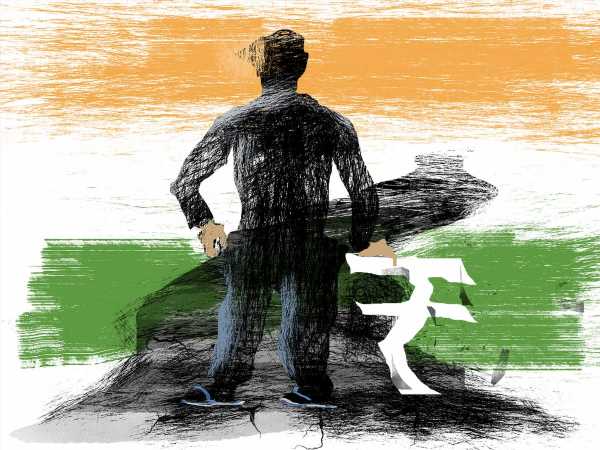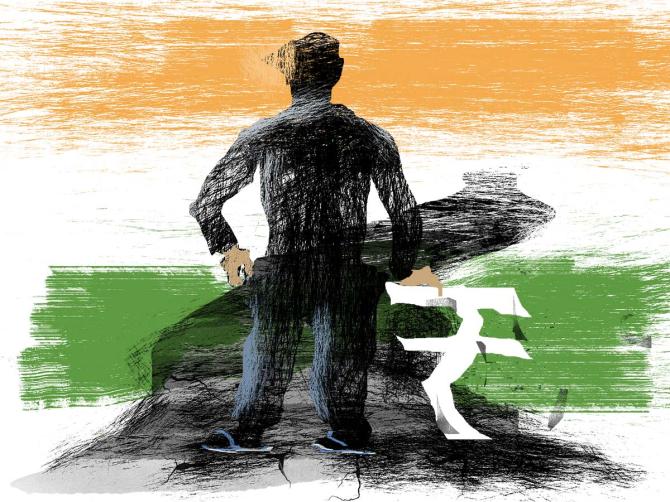The employment situation remains dire.
Whatever can be done to promote greater low-skill employment should be pursued aggressively, advises former chief economic adviser Shankar Acharya.
Against the backdrop of sharply slowing economic growth over 2018-2020, the Covid/lockdown shock of 2020-2021, the K-shaped recovery thereafter and the legacy of record fiscal deficits and government debt-GDP ratios, fiscal year 2022-2023 (FY23) was always going to be challenging for macroeconomic management.
After the Union Budget a couple of months ago, I expected real GDP growth in FY23 to be about 7 per cent (mainly thanks to the low-base ‘benefit’ of the Delta shock in 2021-2022 Q1), inflation, as measured by the broad-based GDP deflator, to be around 6-7 per cent and nominal GDP growth to be 13-14 per cent.
Global economy weakens
Since then, the global economic environment has worsened considerably on account of several factors:
The sharp increase in inflation since February in America and some European nations, triggering a rise in policy and other interest rates in these jurisdictions;
- The sizable outbreaks of Omicron in China, leading to strong lockdowns of major cities, including Shanghai;
- The Russo-Ukrainian war, which spawned unprecedented economic sanctions against Russia by the US-led ‘Western’ alliance, soaring prices of oil, fertilisers, metals, food grains and other commodities and major supply disruptions.
The net result is that world economic growth will be significantly lower than projected in January by the IMF, world trade expansion will also be slower and net capital flows to developing countries will be substantially weaker as private capital seeks ‘safe havens’, especially in the US.
Just how bad these effects will be for the international economy will depend on the duration and intensity of the European war and the Western economic sanctions, the trajectory of the Covid pandemic in China and elsewhere and the extent and duration of tighter monetary policies in the US and other major economies.
Impact on India
For India, the marked worsening of the world economy will mean lower economic growth, higher inflation, a deterioration in the external payments balance on account of both negative foreign trade effects and reduced inflows of net foreign capital, and heightened pressures on our already strained fiscal situation.
The extent of the damage to economic prospects will depend on the duration and degree of weak global economic performance as well as the nature of our policy responses and, of course, the quality of the summer monsoon.
At this early stage, one can only guess at outcomes in key macro parameters in FY23.
For what it’s worth (which may not be much) my preliminary guesses suggest real GDP growth of 6 per cent or lower, a rise in inflation to 7-8 per cent as per the GDP deflator and around 7 per cent plus in the consumer price index, nominal GDP growth of 12-14 per cent, a current account deficit in our balance of payments in the order of 2.5-3.0 per cent of GDP (depending crucially on international oil price trends), some depreciation of the rupee, and a central government budget deficit of around 6.5-7.0 per cent of GDP.
These tentative projections are only a little more bearish than those presented by the Reserve Bank of India in its Monetary Policy Statement.
The RBI projects growth at 7.2 per cent for FY23 and consumer price inflation (CPI) at just under 6 per cent.
Interestingly, this 7 per cent plus anticipated growth of GDP is mostly because of the low-base benefit to be reaped in the first quarter, April-June.
The year-on-year, successive quarterly growth rates forecast by the RBI are 16.2 per cent, 6.2 per cent, 4.1 per cent and 4.0 per cent.
Put another way, RBI expects y-o-y GDP growth to slump to an average of 4.6 per cent in the final three quarters and an even lower 4 per cent in the second half of FY23.
What should India do?
Against this challenging background my suggestions for the broad direction of desirable policy responses are as follows:
- First, the government must strive to meet budgeted fiscal targets for expenditure and revenues. The adverse terms of trade shift stemming from global developments is akin to a supply shock which cannot be ‘cured’ through higher fiscal deficits, certainly not at a time when our government debt-to-GDP ratio is at a record 90 per cent and the combined (Centre and states) fiscal deficit is at an elevated 10-11 per cent of GDP.
Second, the recently announced beginning of withdrawal in exceptionally accommodative monetary policy should be pursued a little faster (the RBI has been a little ‘behind the curve’) to head off consumer price inflation from gathering momentum above 6 per cent.
The repo rate needs to be raised and soon (perhaps immediately), if sharper increases are to be avoided in future.
Third, we should use our ample forex reserves to keep ‘soft brakes’ on rupee depreciation to preclude destabilising volatility, but allow the necessary depreciation while refraining from attempting to defend any particular parity.
Fourth, the government must make every effort to implement its ambitious public investment programme, especially in infrastructure.
Fifth, while the recently concluded first stages of free trade agreements (FTAs) with the UAE and Australia constitute promising signs of a new pro-trade policy, they are unlikely to significantly correct India’s weak participation in global and regional supply chains.
For that to occur (and thus strengthen sustainable export growth, related investment and manufacturing competitiveness) the best approach would be for us to leverage our observer status in the Regional Comprehensive Economic Partnership (RCEP) to re-apply and join this most dynamic of ‘mega-regional’ FTAs.
This is particularly important at a time when WTO disciplines are likely to be subject to substantial geopolitical pressures.
Sixth, the employment situation remains dire.
Whatever can be done to promote greater low-skill employment through policies (such as implementation of new labour codes) or reform of job-discouraging procedures should be pursued aggressively.
Higher rates of export growth will also help.
All this will not compensate fully for slower global growth and the adverse terms of trade shock.
But it should help minimise the costs in terms of higher inflation, losses in output and employment and heightened external financial vulnerability.
Shankar Acharya is Honorary Professor at ICRIER and former Chief Economic Adviser to the Government of India.
Feature Presentation: Aslam Hunani/Rediff.com
Source: Read Full Article


